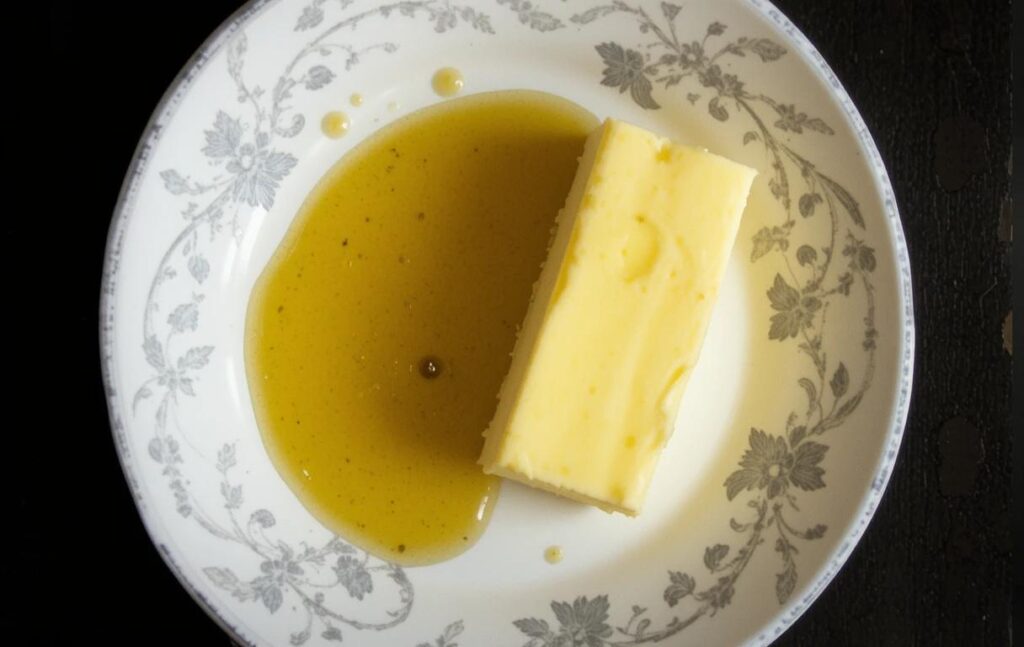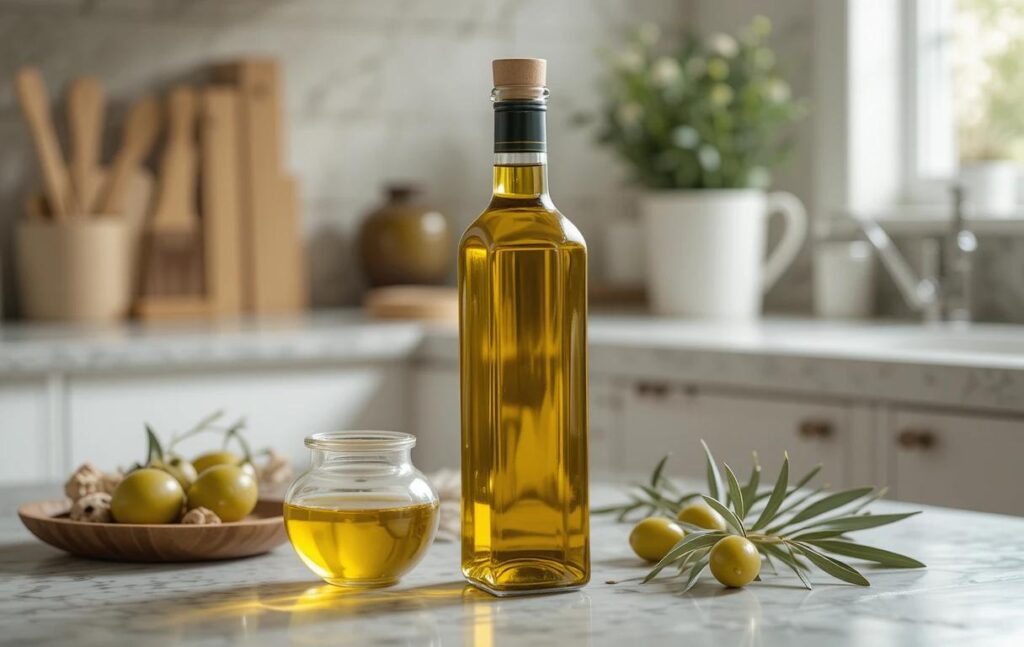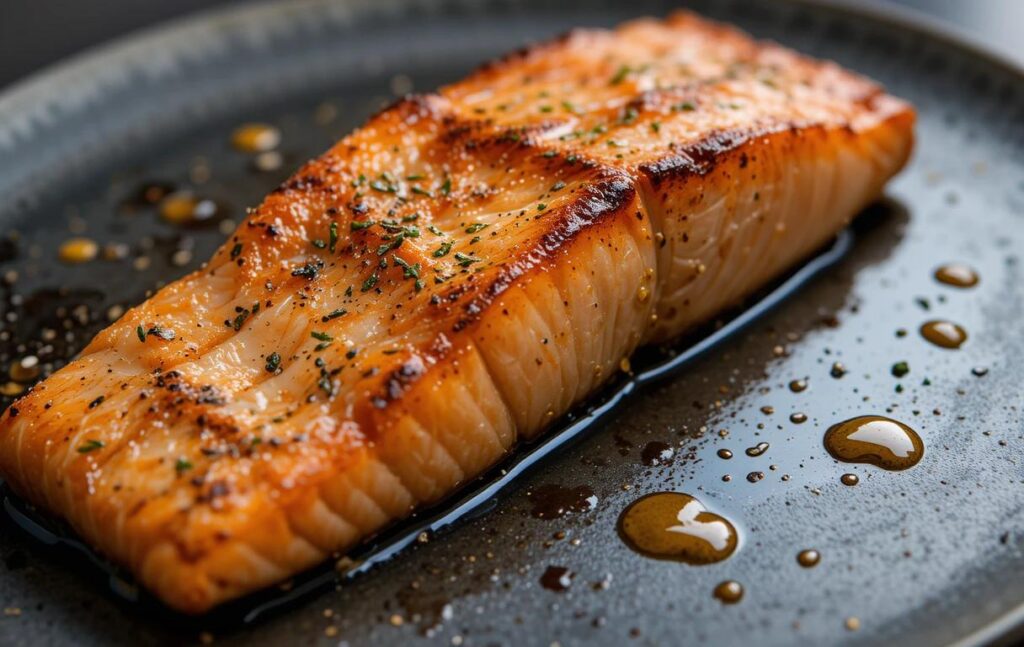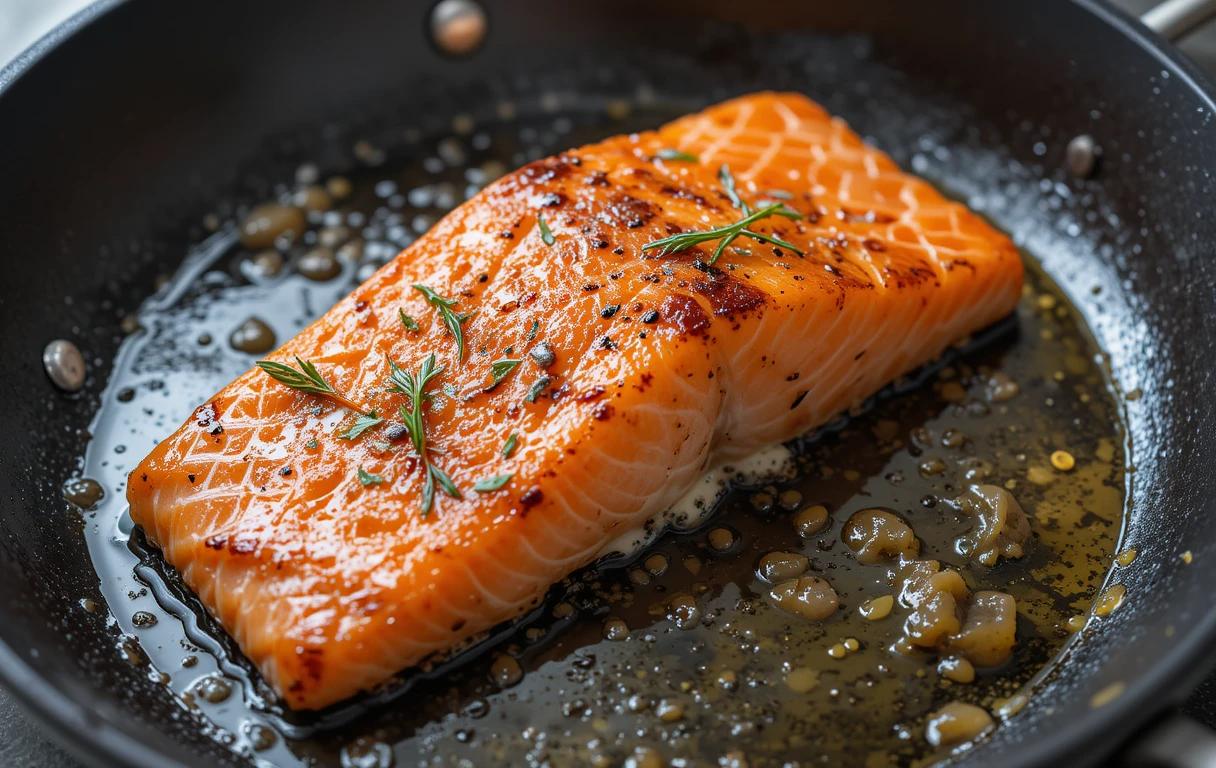Cooking salmon perfectly can be a daunting task, especially when faced with the decision of whether to use butter or oil. Each option offers unique benefits, impacting the texture, flavor, and nutritional profile of this popular fish. If you’ve ever wondered whether you should opt for butter’s rich flavor or oil’s versatility, you’re not alone.
In this article, we’ll dive deep into the differences between butter and oil for cooking salmon. From the nutritional aspects to flavor impacts, and even the best cooking methods, this guide will help you make the right choice for your next salmon dish.
Understanding the Basics of Cooking Salmon
Salmon is a versatile fish, beloved for its rich flavor, tender texture, and nutritional benefits. However, getting it just right can depend on your cooking methods and the fats you choose. Whether you prefer a crispy sear, a moist bake, or a grilled masterpiece, choosing between butter and oil can significantly influence your results.
Why Fats Matter in Cooking Salmon
Fats play an essential role in cooking salmon, influencing how it cooks, tastes, and even feels. Here’s why they matter:
- Heat Conduction: Fats help transfer heat evenly to the fish, preventing it from sticking or drying out.
- Flavor Infusion: Butter or oil enhances the natural taste of salmon while adding its unique flavor notes.
- Texture: Depending on the fat used, salmon can turn out crispy, tender, or silky smooth.
Both butter and oil can help achieve these goals, but their characteristics differ, making them suited for specific methods or flavors.
Common Cooking Methods for Salmon
The choice between butter and oil often depends on how you plan to cook the salmon. Popular methods include:
- Pan-Searing: Known for creating a crispy, caramelized crust.
- Grilling: Ideal for achieving a smoky, charred flavor.
- Baking: A gentler method that locks in moisture and infuses flavor.
- Poaching: For an ultra-moist texture, where oil or butter can add richness to the cooking liquid.
For pan-searing, either butter or oil can work, while grilling generally favors oil for its higher smoke point. Baking allows you to use either, depending on the desired flavor profile.
Smoke Point Considerations
One key factor in choosing between butter and oil is their smoke point—the temperature at which fat starts to break down and smoke.
- Butter: Smoke point around 350°F (177°C). Best for low-to-medium heat cooking like sautéing or baking.
- Oil (e.g., olive oil): Smoke points vary but generally range from 375°F to 470°F (190°C to 243°C). Suitable for high-heat methods like grilling or searing.
If you’re cooking salmon at high temperatures, oil may be the safer option to prevent burnt flavors. For medium to low heat, butter offers unparalleled richness.
Butter vs. Oil: Nutritional Differences

When deciding whether to use butter or oil for cooking salmon, it’s important to consider how each option contributes to your overall nutritional goals. Both fats have distinct advantages, and the right choice often depends on your health priorities and flavor preferences.
A Closer Look at Butter
Butter is a natural fat made from cream, and it’s celebrated for its rich, creamy flavor that pairs beautifully with salmon. However, its nutritional profile might not appeal to everyone.
- Calories: One tablespoon of butter contains around 100 calories.
- Fat Composition: Butter is about 80% fat, with a mix of saturated fats and small amounts of monounsaturated fats.
- Vitamins: It provides fat-soluble vitamins like Vitamin A, D, E, and K.
- Cholesterol: Butter contains cholesterol, which might be a concern for individuals watching their cholesterol levels.
When cooking salmon, butter not only enhances flavor but also helps create a golden, caramelized crust due to its milk solids.
A Closer Look at Oil
Cooking oils vary significantly in their nutritional profiles, depending on the type. Here’s a breakdown of some common options:
- Olive Oil: Rich in monounsaturated fats, low in saturated fats, and a source of antioxidants. It’s heart-healthy and contains about 120 calories per tablespoon.
- Avocado Oil: High in monounsaturated fats and Vitamin E, with a high smoke point ideal for high-heat cooking. Similar caloric content to olive oil.
- Grapeseed Oil: Light and neutral, grapeseed oil has polyunsaturated fats and Vitamin E. It’s a good option for frying or grilling.
Unlike butter, oils don’t contain cholesterol, and many are praised for their health benefits, especially for heart health.
Comparing Health Benefits
| Nutrient | Butter | Olive Oil | Avocado Oil |
|---|---|---|---|
| Calories | ~100 per tablespoon | ~120 per tablespoon | ~120 per tablespoon |
| Saturated Fat | High (~7g) | Low (~2g) | Low (~2g) |
| Monounsaturated | Moderate (~3g) | High (~10g) | High (~10g) |
| Vitamins | A, D, E, K | E, antioxidants | E, antioxidants |
| Cholesterol | Yes (~30mg per tbsp) | None | None |
Butter: Best for indulgent flavors and dishes.
Oil: Healthier for everyday cooking, especially heart-healthy oils like olive or avocado.
When to Choose Butter Over Oil
Butter is ideal when you want to:
- Add richness to your salmon.
- Achieve a golden, caramelized crust.
- Complement certain flavor profiles, such as garlic, lemon, or herbs.
It’s also the go-to choice for indulgent recipes like pan-seared salmon with herb butter.
When to Choose Oil Over Butter
Oil might be the better choice if you:
- Are cooking at high heat, such as grilling.
- Want a lighter, healthier fat option.
- Prefer neutral or fruity flavors (e.g., olive oil).
For grilling and frying, oils with high smoke points like avocado or grapeseed are especially beneficial.
Transition to the Next Section
Now that you know the nutritional differences, let’s dive into how butter and oil impact the flavor and texture of your salmon.
How Butter and Oil Enhance the Flavor of Salmon
The choice between butter and oil often comes down to the flavor profile you want to achieve. Each option interacts with salmon in distinct ways, bringing out different aspects of its natural richness. Let’s explore how butter and oil enhance salmon and why you might lean toward one over the other.
Butter: The Flavor Enhancer
Butter is beloved for its ability to elevate the flavor of almost any dish, and salmon is no exception. Its creamy, savory richness complements the fatty, tender texture of salmon, making it an ideal pairing. Here’s how butter works its magic:
- Caramelization: The milk solids in butter help create a golden, slightly crisp crust when pan-seared.
- Flavor Infusion: Butter melts into salmon, blending with its natural juices and enhancing its umami flavors.
- Versatility: It pairs beautifully with garlic, lemon, dill, and other herbs, making it a fantastic choice for recipes like herb-butter salmon.
Best Cooking Methods with Butter:
- Pan-Searing: Creates a restaurant-quality crust.
- Baking: Adds a luscious, silky texture when dolloped on top.
- Basting: Ensures even cooking and rich flavor infusion.
Oil: A Lighter, More Versatile Option
Cooking with oil brings out salmon’s natural flavors while allowing for a lighter, crisper texture. Oils vary widely in taste, from the robust notes of extra-virgin olive oil to the neutral profile of grapeseed oil. Here’s what makes oil stand out:
- Neutrality: Light oils, such as canola or grapeseed, let salmon’s flavor shine without overpowering it.
- Fruity Notes: Olive oil adds a subtle, peppery fruitiness that pairs well with Mediterranean-style dishes.
- Consistency: Oil creates a uniform cooking surface, preventing sticking and ensuring even browning.
Best Cooking Methods with Oil:
- Grilling: Handles high heat without burning.
- Pan-Searing: Helps achieve a clean, crisp texture.
- Marinades: Infuses salmon with flavor before cooking.
Comparing Flavor Impacts
| Characteristic | Butter | Oil |
|---|---|---|
| Richness | Adds creamy, indulgent notes | Lighter, highlights natural salmon flavor |
| Crispness | Enhances crust through caramelization | Achieves a clean, crisp finish |
| Flavor Pairing | Pairs with herbs, garlic, and citrus | Complements Mediterranean spices, marinades |
While butter is ideal for indulgent, flavorful dishes, oil offers versatility for a variety of cuisines and cooking techniques.
The Role of Infused Butter and Oils
Adding herbs, spices, or aromatics to butter or oil can elevate your salmon to new heights. Consider these options:
- Herb Butter: Combine butter with parsley, thyme, or dill for a simple flavor boost.
- Garlic Butter: Adds richness and depth, perfect for baked salmon.
- Infused Oils: Garlic-infused or chili-infused oils can add a subtle kick to grilled salmon.
These enhancements can bring out the best in your salmon while catering to your personal tastes.
Transition to the Next Section
Now that we’ve covered how butter and oil affect flavor, let’s explore specific oils that work best for cooking salmon.
Best Oils for Cooking Salmon

Choosing the right oil for salmon can significantly impact the cooking process and the final flavor. Not all oils are created equal—some are better suited for high heat, while others excel in low-to-medium-heat applications. Here’s a closer look at the best oils for cooking salmon and their unique qualities.
Olive Oil: The Classic Choice
Olive oil is a popular choice for cooking salmon, especially for those seeking a heart-healthy option. It’s versatile, flavorful, and works well with a range of cooking methods.
- Flavor Profile: Extra-virgin olive oil (EVOO) adds a fruity, slightly peppery flavor that enhances salmon’s natural richness.
- Smoke Point: Around 375°F (190°C), making it suitable for baking or light pan-searing.
- Health Benefits: High in monounsaturated fats and antioxidants, olive oil supports heart health and reduces inflammation.
Best Uses:
- Drizzle over baked salmon.
- Use for light sautéing or as part of a marinade.
Avocado Oil: A Healthy Alternative
Avocado oil is prized for its high smoke point and mild flavor, making it an excellent option for salmon cooked at high heat.
- Flavor Profile: Subtle, buttery, and neutral, allowing salmon’s flavor to shine.
- Smoke Point: A remarkable 520°F (271°C), ideal for grilling or pan-searing.
- Health Benefits: Packed with monounsaturated fats and Vitamin E, avocado oil supports skin and heart health.
Best Uses:
- Grilling salmon for a clean, charred finish.
- Pan-searing for crispy, golden edges.
Pro Tip: Use avocado oil as a marinade base to lock in moisture and flavor.
Grapeseed Oil: The Neutral Option
Grapeseed oil is another versatile choice, known for its neutral taste and high smoke point.
- Flavor Profile: Mild and neutral, ideal for when you don’t want the oil to overpower the salmon’s natural flavor.
- Smoke Point: Around 420°F (216°C), suitable for high-heat cooking methods like grilling or roasting.
- Health Benefits: Rich in Vitamin E and polyunsaturated fats, promoting heart health.
Best Uses:
- Use for frying or searing salmon.
- Pair with bold seasonings, as its neutral flavor won’t clash.
Coconut Oil: A Unique Choice
Coconut oil is less common but offers a unique twist when cooking salmon, especially in tropical or Asian-inspired dishes.
- Flavor Profile: Adds a hint of sweetness and nuttiness.
- Smoke Point: Refined coconut oil can handle up to 450°F (232°C), while unrefined has a lower smoke point of 350°F (177°C).
- Health Benefits: Contains medium-chain triglycerides (MCTs) that provide quick energy.
Best Uses:
- Baking salmon with a tropical glaze.
- Pairing with spices like turmeric or curry.
Specialty Oils: Sesame and Walnut
For a gourmet touch, specialty oils like sesame or walnut can bring bold flavors to salmon dishes.
- Sesame Oil: Adds a nutty, toasty flavor perfect for Asian recipes like teriyaki salmon. Use as a finishing oil rather than for cooking.
- Walnut Oil: Best used in dressings or drizzled over cooked salmon for a rich, earthy flavor.
Pro Tip: Use specialty oils sparingly to avoid overpowering the dish.
When to Combine Oils
For high-heat cooking, consider blending oils to balance flavor and performance. For example, mix olive oil with avocado oil for grilling to combine flavor and a higher smoke point. This approach ensures your salmon cooks perfectly without compromising on taste.
Techniques for Cooking Salmon with Butter or Oil

Cooking salmon to perfection requires the right technique, and the choice between butter and oil can influence the outcome. Whether you prefer a crispy sear, a smoky grill, or a moist baked filet, understanding the best methods will ensure delicious results every time.
Pan-Searing Salmon
Pan-searing is a popular technique that creates a golden crust while keeping the inside tender.
Steps for Pan-Searing with Butter or Oil:
- Prep the Pan: Use a heavy-bottomed skillet (like cast iron) to ensure even heat distribution. Heat the pan over medium-high heat.
- Choose Your Fat: For a rich flavor, melt 1-2 tablespoons of butter. If using oil, choose one with a high smoke point like avocado or olive oil.
- Season the Salmon: Pat the salmon dry with paper towels and season with salt, pepper, and optional spices like paprika or garlic powder.
- Cook Skin Side Down: Place the salmon skin-side down in the pan. Cook for 4-5 minutes without moving to let the skin crisp up.
- Flip and Finish: Flip the salmon carefully and cook for an additional 2-3 minutes until the flesh is opaque. For added flavor, baste the salmon with melted butter or oil during the final minute.
Pro Tip: For high-heat searing, combine butter with oil to prevent burning while keeping the flavor.
Grilling Salmon
Grilling salmon is perfect for achieving a smoky, charred flavor. Oil is usually preferred for grilling due to its high smoke point.
Steps for Grilling with Oil:
- Preheat the Grill: Heat your grill to medium-high (around 375°F to 400°F).
- Prepare the Filet: Brush the salmon generously with olive or avocado oil to prevent sticking. Season with salt, pepper, and fresh herbs.
- Oil the Grates: Use a paper towel dipped in oil to coat the grill grates lightly.
- Grill Skin Side Down: Place the salmon skin-side down and grill for 6-8 minutes, depending on the thickness. Avoid flipping to keep the filet intact.
- Check for Doneness: The salmon is done when it flakes easily with a fork and the internal temperature reaches 145°F (63°C).
Pro Tip: Add lemon slices or fresh dill on top of the salmon while grilling for added aroma and flavor.
Baking Salmon
Baking is a gentle method that locks in moisture, making it perfect for delicate salmon filets. Both butter and oil work well, depending on the flavor profile you prefer.
Steps for Baking with Butter or Oil:
- Preheat the Oven: Set your oven to 375°F (190°C).
- Prepare the Filet: Place the salmon on a lined baking sheet. For butter, add small pats on top of the filet. For oil, brush the filet lightly and season.
- Add Aromatics: Enhance the flavor with garlic, lemon slices, fresh dill, or parsley.
- Bake: Bake for 12-15 minutes or until the salmon is cooked through (internal temperature of 145°F/63°C).
- Optional Finish: Broil for the last 2 minutes to create a caramelized surface.
Pro Tip: Cover the salmon with foil while baking to trap steam and ensure a moist result.
Using Butter or Oil for Basting
Basting involves spooning melted butter or oil over salmon during cooking to enhance flavor and keep it moist.
- With Butter: Add garlic, thyme, or rosemary to melted butter for a rich, aromatic basting liquid.
- With Oil: Infuse olive or avocado oil with crushed garlic or chili flakes for a flavorful drizzle.
Basting works especially well for pan-seared and oven-baked salmon.
Tips for Perfect Salmon Every Time
- Don’t Overcook: Overcooking salmon dries it out. Use a meat thermometer to check for an internal temperature of 145°F (63°C).
- Let it Rest: Allow cooked salmon to rest for 2-3 minutes before serving to retain its juices.
- Experiment with Flavors: Combine butter or oil with herbs, spices, or zests to create unique flavor profiles.
FAQs: Butter or Oil for Salmon?
Q1: Can I use both butter and oil when cooking salmon?
Yes, combining butter and oil is a great technique! The oil’s higher smoke point prevents the butter from burning, while the butter adds rich flavor. This is especially useful for pan-searing salmon at higher temperatures.
Q2: Which oil is best for grilling salmon?
Avocado oil is one of the best options for grilling due to its high smoke point and neutral flavor. Olive oil is also a great choice for medium-heat grilling, adding a fruity undertone to the salmon.
Q3: How can I prevent salmon from sticking to the pan or grill?
To prevent sticking:
- Heat the pan or grill before adding the salmon.
- Lightly coat the surface with oil.
- Ensure the salmon is dry before cooking and don’t move it until it naturally releases.
Q4: Is butter bad for high-heat cooking?
Butter alone can burn at high heat due to its low smoke point. If you need the flavor of butter but are cooking at high temperatures, use clarified butter (ghee) or mix butter with a high-smoke-point oil like avocado or grapeseed oil.
Q5: What’s the healthiest option for cooking salmon?
If you’re prioritizing health, opt for oils high in monounsaturated fats, such as olive oil or avocado oil. These are heart-healthy choices that complement salmon’s own omega-3 fatty acids.
Q6: Can I use flavored oils or butter?
Absolutely! Infused oils (like garlic or chili oil) and flavored butter (like herb or lemon butter) can elevate the dish and create a gourmet experience.
Conclusion: Which Should You Choose?
The choice between butter and oil for cooking salmon depends on your preferences and cooking method:
- Butter: Ideal for indulgent, flavorful dishes and medium-to-low heat cooking like baking or pan-searing. Butter’s rich taste makes it perfect for recipes where flavor is a priority.
- Oil: A versatile, heart-healthy option that excels in high-heat methods like grilling and frying. Oils such as olive or avocado provide a clean, crisp finish while letting salmon’s natural flavor shine.
For the best of both worlds, consider using a combination of butter and oil to balance flavor and performance. Whether you’re grilling a smoky filet or baking a buttery masterpiece, your choice of fat can transform a simple piece of salmon into a culinary delight.
Recipe: Garlic Lemon Butter Salmon
Related Recipes
- “Tuna Tomato Sauce Pasta Recipe“: A tomato-based recipe showcasing another way to use tomatoes.
- “Baked Chicken Fettuccine Alfredo with Broccoli“: Another comforting dish that can be complemented with tomato-based sauces.
Ingredient-Focused Content
- “Lions Mane Mushroom Recipe“: Suggest using a tomato gravy as a flavorful addition for plant-based dishes.
Cooking Techniques and Enhancements
- “Mango Habanero Salsa“: Explore complementary uses of sauces and gravies for flavor diversity.
Storage and Reuse Tips
- “Sous Vide Recipes“: Recommend tomato gravy as a sauce for sous vide-cooked meats or vegetables.
- “Ocean Spray Cranberry Sauce Recipe“: Guide readers on making and storing sauces, including tomato gravy.

